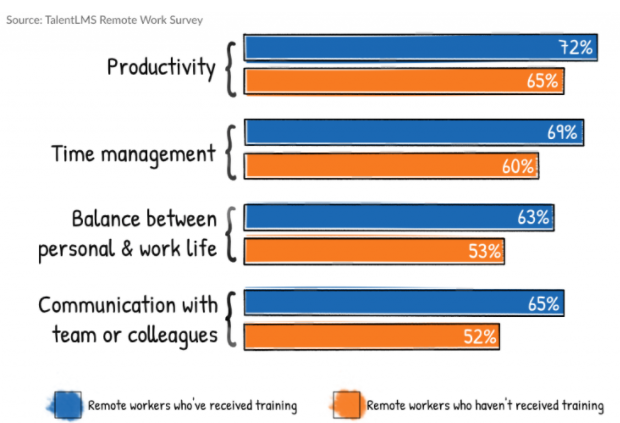The allure of working from home is flexibility.
Remote teams could work flexible hours yet achieve the desired goal. However, managing a remote team is a bit different than what to expect if they worked on-site.
With 88 percent of organizations adopting a remote workstyle, employers still expect high productivity, regardless of location and situations that arise. Therefore, it is left to remote team leads to figure out the best way to lead this new and bulging remote workforce to guarantee improved performance.
In this article, we’ll take a look at how you can improve remote efficiency and track your team’s performance. Let’s get started.
How Leadership Dynamics Change As You Move To A Remote Team
Remote working had gradually been gaining momentum before the 2019 pandemic. But, when small businesses and organizations went on a lockdown spree (for health reasons), more than 80 percent of the workforce switched to the work from home (WFH) model.
There’s every indication that as businesses reopen their on-site offices, they’d retain some aspect of these workforce changes. Why? The transition is not as easy. Besides, many companies have come to realize that remote work is cost-effective for everyone.
Source: Gartner
Remote leadership takes on a new dynamic. However, the leadership basics essentially remain the same — be proactive, set clear goals and clearer expectations, offer team support, mentorship, and guidance.
As a remote team project manager, you’ll have to adapt to these changes. For instance, many remote teams are more effective using a pseudo-flat hierarchy.
When issues arise, they might quickly resolve challenges themselves or call colleagues to help them out. In situations when they can’t, they’ll have unfettered access to you using asynchronous channels.
This might not be the case if your team worked on-site and had to go through excess management layers to get to you. But, again, lack of communication and accessibility to resources might pose a problem.
It’s your job as the remote team lead to curb these challenges using practical leadership skills.
What To Avoid When You’re Leading A Remote Team
Having to anticipate the needs and challenges you cannot see makes managing a remote team more challenging than leading an in-person workforce.
Where a lot of remote managers fail is setting clear rules of engagement. In many cases, when the office work process is dropped, a newly structured process isn’t set up to replace it. This creates a situation where their supervisor constantly hassles team members who would naturally function efficiently without supervision.
A senior executive at Chegg, Nathan Schultz, observed that once he overcame his impulse to check in on employees constantly, the productivity went up. Employees started completing projects ahead of schedule.
It’s also a good idea to set and stick to work hours.
Don’t assume remote staff is available for calls and emails at all hours of the day. The pressure to attend to work communication out of hours is a major contributor to burnout even among seasoned remote workers.
Instead, schedule important work emails to be delivered at the appropriate time in the next working day. Provide access to work and email scheduling apps that will make remote collaboration smoother.
The Metrics You Need To Track
Many businesses have implemented frequent manager-employee check-ins to track performance remotely and improve productivity.
The nature of this interaction can vary, but remote leaders must pay attention to the most crucial performance indicators.
Granted, you’d still need to ensure Jerry clocks in for work at the right time of the day, just as before. Except, now it doesn’t matter if he’s doing it from the office at home, while frying up a batch of bacon for breakfast, or with his toes buried in beach sand.
Besides, work hours hardly translate into better performance, especially with 63 percent of remote workers unable to separate work from the rest of their non-work life.
Source: Pipefy
More significant KPIs to track in your remote team include:
- Weekly deliverables completion rate: Like word count written by writers or screens created by designers in a week.
- Customer satisfaction rate: To measure the customer satisfaction score of remote customer service teams.
- Leads generated and conversion rates: Track marketing teams’ performance by how many new leads team members bring into the pipeline and how many of those leads turn into buyers.
- Sales revenue: How much monthly revenue is each member of your team bringing in?
- Schedule variance: to measure how remote teams are meeting up delivery deadlines.
As important as it is to track remote team performance, it is also essential to communicate requirements and expectations. Often, an employee’s work delivery misses the mark because you could not communicate the “why” of the task.
Source: Pipefy
Up to 20 percent of remote workers are uncertain of their remote manager’s expectations. You can bet this will affect their performance.
Train Your Team To Be More Productive
The recommended approach to effective remote leadership is to set up clear remote workplace policies in advance.
However, it’s not always practicable to make a remote work transition plan considering the abrupt WFH policies implemented by companies to pull through the pandemic. So, it’s expected that remote teams and managers would go through a period of adjustment before efficiency is restored.
It is obvious remote teams can be just as effective as the rest of the office workforce. Although, the numbers don’t match up in all industries, professions, and locations.
For instance, an Institute of Labor Economics study confirmed a 20 percent decrease in the productivity of remote-working IT professionals in Asia.
Source: IZA
But, despite the sudden switch to remote working around April/March of 2020, average productivity improved by 47 percent. The difference is attributed, in some cases, to employers’ “out of sight, out of mind” approach to remote working.
Not to mention, without the in-person interaction of an on-site workplace, remote teams are separated from the mentorship and guidance they need to improve.
Source: Udemy
That is why, for successful remote leadership, you must set down and communicate a plan for training and upskilling the team. You’ll need to also provide them with access to relevant resources. For example, a company style guide everyone can refer to.
Source: Talent LMS
Besides work-based skill training, also anticipate and provide for the emotional needs of the team. For example, provide access to training on personal and work-life balance, relaxation techniques, sleep therapy, and general well-being.
Wrapping Up
Achieving successful remote leadership is a balancing act. You must anticipate the team’s needs while avoiding intrusion and micromanagement. But good managers could easily transfer their on-site team leadership skills to improve the efficiency of remote teams in a short time.
One of the essential things to look out for is tracking remote workforce performance based on KPIs that directly measure productivity rather than on input work hours.
The majority of the US workforce who have transitioned to a WFH arrangement experience greater focus in their work and an increase in productivity compared to their on-site workdays.
But a solid plan for training and mentorship will help a remote leader sustain this efficiency.











Leave A Comment